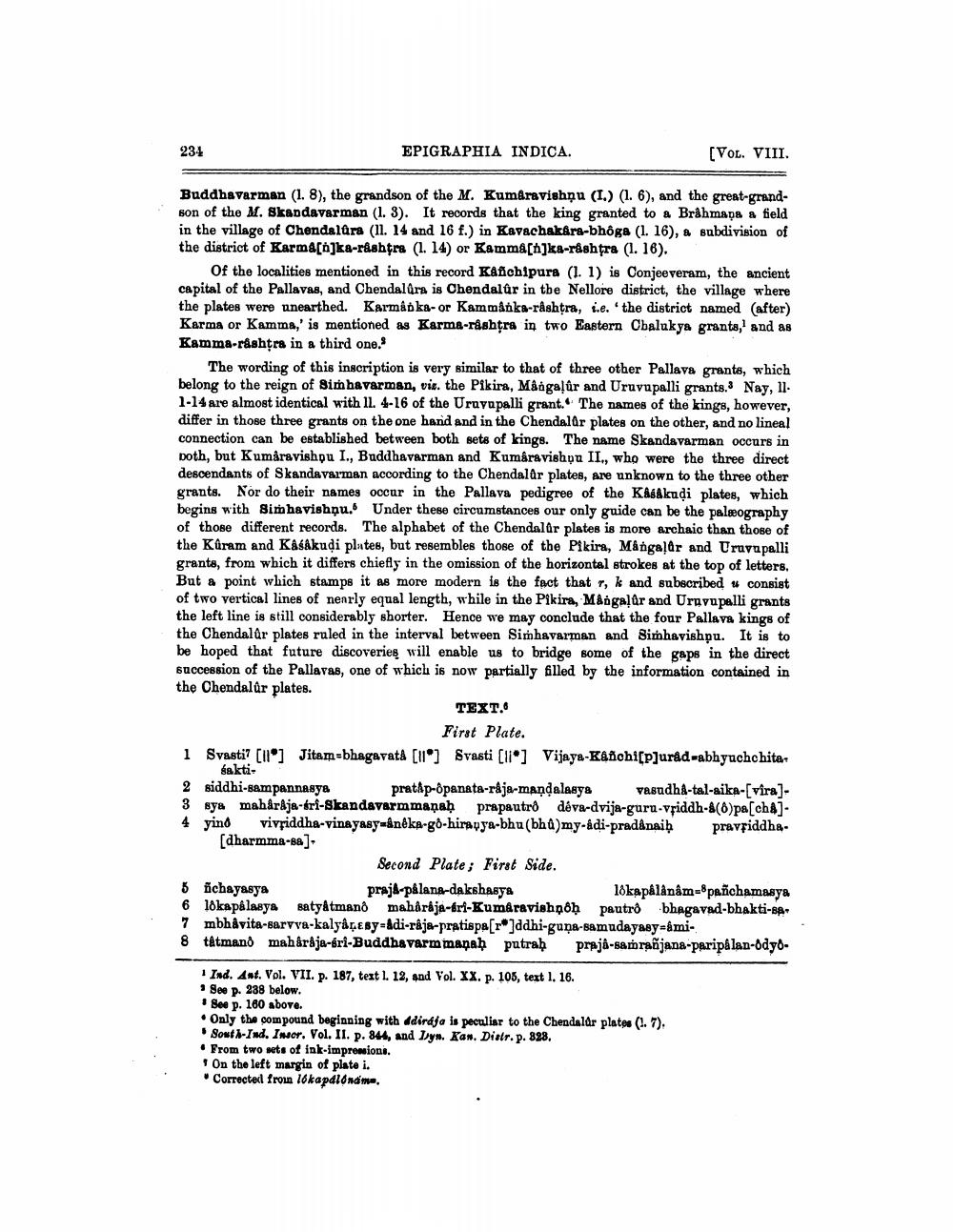________________
234
EPIGRAPHIA INDICA.
(VOL. VIII.
Buddhavarman (1. 8), the grandson of the M. Kumaravishņu (I.) (1.6), and the great-grandson of the M. Skandavarman (1. 3). It records that the king granted to a Brahmapa a field in the village of Chendalúra (11. 14 and 16 f.) in Kavachak ra-bhoga (1. 16), a subdivision of the district of Karma[0]ka-rashtra (1. 14) or Kamma[n]ka-rashtra (1. 16).
Of the localities mentioned in this record Kåfichipura (1. 1) is Conjeeveram, the ancient capital of the Pallavas, and Chendalara is Chendalûr in the Nellore district, the village where the plates were unearthed. Karmab ka-or Kammanka-rashtra, i.e. the district named after) Karma or Kamma,' is mentioned as Karma-råshtra in two Eastern Cbalukya grants, and as Kamma-rashtra in a third one.
The wording of this inscription is very similar to that of three other Pellava grants, which belong to the reign of Simbavarman, via the Pikira, Mangaļûr and Uruvupalli grants. Nay, 11. 1-14 are almost identical with 11. 4-16 of the Urayapalli grant. The names of the kings, however, differ in those three grants on the one hand and in the Chendelor plates on the other, and no lineal connection can be established between both sets of kings. The name Skandavarman occurs in poth, but Kumaravishpu I., Buddhavarman and Kumaravishịu II., who were the three direct descendants of Skandavarman according to the Chendalár plates, are unknown to the three other grants. Nor do their names occur in the Pallava pedigree of the Kasakuļi plates, which begins with sim havishņu. Under these circumstances our only guide can be the palæography of those different records. The alphabet of the Chendalûr plates is more archaic than those of the Kuram and Kåsakuļi plates, but resembles those of the Pikira, Mangaļâr and Uruyupalli grants, from which it differs chiefly in the omission of the horizontal strokes at the top of letters, But a point which stamps it as more modern is the fact that r, k and subscribed 4 consist of two vertical lines of nenrly equal length, while in the Pikira, Mångalûr and Uravupalli grants the left line is still considerably shorter. Hence we may conclude that the four Pallava kings of the Chendalúr plates ruled in the interval between Simhavarman and Sinhavishpu. It is to be hoped that future discoveries will enable us to bridge some of the gaps in the direct succession of the Pallaras, one of which is now partially filled by the information contained in the Chendalûr plates.
TEXT.
First Plate. 1 Svasti? [ll] Jitam-bhagavata [11] Svasti (li*] Vijaya-Kanchi(p]urád-abhyachchita
sakti. 2 siddhi-sampannasya pratAp-panata-raja-mandalagya vasudhA-tal-aika-(vira)3 sya mahår&ja-tri-Skandavarmmaņaḥ prapautrô deva-dvija-guru-vsiddh-&()pa[ch]4 yino vivriddha-vinayasy-Aneka-gô-hirapya-bhu(bhd)my-adi-pradânaiḥ pravşiddha(dharmma-sa].
Second Plate; First Side. 8 fichayasya praja-pålana-dakshasya
18kapálânâm=&pañchamasya 6 18kapalasya satyâtmanð maharaja-ri-Kumâravishnôh pautrở bhagavad-bhakti-ba7 mbhävita-barvya-kalyatesy-Adi-raja-pratispa[ro]ddhi-guna-samudayasy=&mi8 tatmanð mahåråja-bri-Buddhavarm manaḥ putraḥ praja-samrañjana-paripálan-odyo
Ind. Ant. Vol. VII. p. 187, text 1. 12, and Vol. XX. p. 105, text 1. 16. See p. 288 below.
Sep. 180 above. • Only the compound beginning with diraja is peculiar to the Chendaldr plates (1. 7).
South-Ind. Iner. Vol. II. p. 844, and Dys. Kan. Disir. p. 828. • From two sets of ink-impronions.
On the left margin of plate i. . Corrected from 16 kapdióname,




